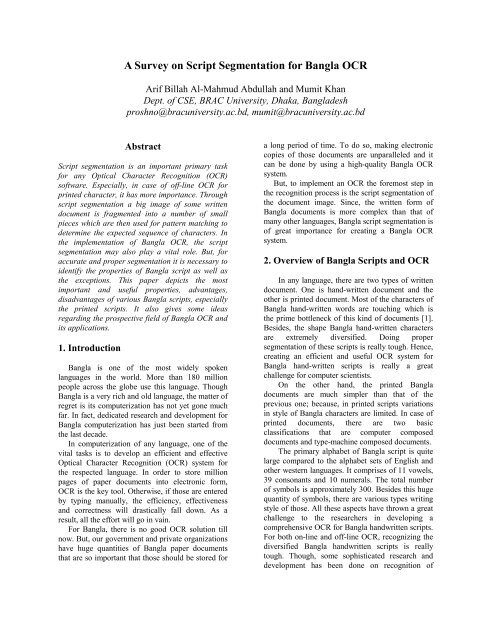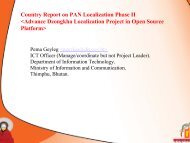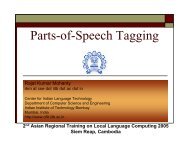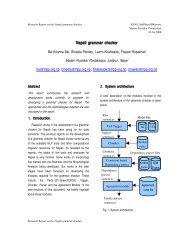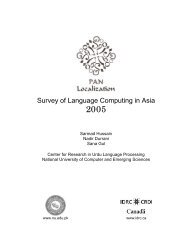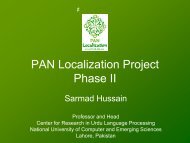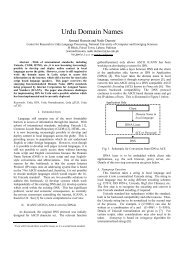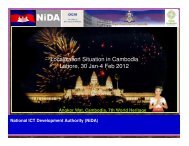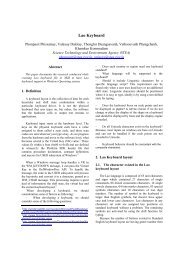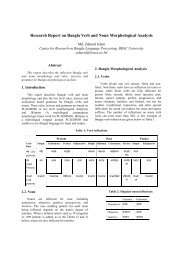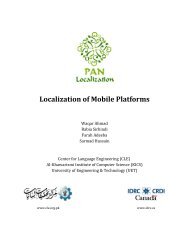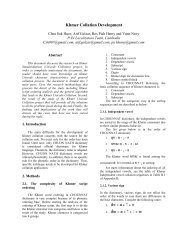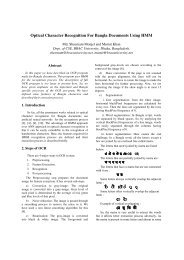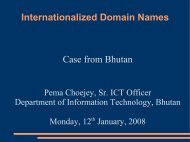A Survey on Script Segmentation for Bangla OCR
A Survey on Script Segmentation for Bangla OCR
A Survey on Script Segmentation for Bangla OCR
Create successful ePaper yourself
Turn your PDF publications into a flip-book with our unique Google optimized e-Paper software.
A <str<strong>on</strong>g>Survey</str<strong>on</strong>g> <strong>on</strong> <strong>Script</strong> Segmentati<strong>on</strong> <strong>for</strong> <strong>Bangla</strong> <strong>OCR</strong><br />
Arif Billah Al-Mahmud Abdullah and Mumit Khan<br />
Dept. of CSE, BRAC University, Dhaka, <strong>Bangla</strong>desh<br />
proshno@bracuniversity.ac.bd, mumit@bracuniversity.ac.bd<br />
Abstract<br />
<strong>Script</strong> segmentati<strong>on</strong> is an important primary task<br />
<strong>for</strong> any Optical Character Recogniti<strong>on</strong> (<strong>OCR</strong>)<br />
software. Especially, in case of off-line <strong>OCR</strong> <strong>for</strong><br />
printed character, it has more importance. Through<br />
script segmentati<strong>on</strong> a big image of some written<br />
document is fragmented into a number of small<br />
pieces which are then used <strong>for</strong> pattern matching to<br />
determine the expected sequence of characters. In<br />
the implementati<strong>on</strong> of <strong>Bangla</strong> <strong>OCR</strong>, the script<br />
segmentati<strong>on</strong> may also play a vital role. But, <strong>for</strong><br />
accurate and proper segmentati<strong>on</strong> it is necessary to<br />
identify the properties of <strong>Bangla</strong> script as well as<br />
the excepti<strong>on</strong>s. This paper depicts the most<br />
important and useful properties, advantages,<br />
disadvantages of various <strong>Bangla</strong> scripts, especially<br />
the printed scripts. It also gives some ideas<br />
regarding the prospective field of <strong>Bangla</strong> <strong>OCR</strong> and<br />
its applicati<strong>on</strong>s.<br />
1. Introducti<strong>on</strong><br />
<strong>Bangla</strong> is <strong>on</strong>e of the most widely spoken<br />
languages in the world. More than 180 milli<strong>on</strong><br />
people across the globe use this language. Though<br />
<strong>Bangla</strong> is a very rich and old language, the matter of<br />
regret is its computerizati<strong>on</strong> has not yet g<strong>on</strong>e much<br />
far. In fact, dedicated research and development <strong>for</strong><br />
<strong>Bangla</strong> computerizati<strong>on</strong> has just been started from<br />
the last decade.<br />
In computerizati<strong>on</strong> of any language, <strong>on</strong>e of the<br />
vital tasks is to develop an efficient and effective<br />
Optical Character Recogniti<strong>on</strong> (<strong>OCR</strong>) system <strong>for</strong><br />
the respected language. In order to store milli<strong>on</strong><br />
pages of paper documents into electr<strong>on</strong>ic <strong>for</strong>m,<br />
<strong>OCR</strong> is the key tool. Otherwise, if those are entered<br />
by typing manually, the efficiency, effectiveness<br />
and correctness will drastically fall down. As a<br />
result, all the ef<strong>for</strong>t will go in vain.<br />
For <strong>Bangla</strong>, there is no good <strong>OCR</strong> soluti<strong>on</strong> till<br />
now. But, our government and private organizati<strong>on</strong>s<br />
have huge quantities of <strong>Bangla</strong> paper documents<br />
that are so important that those should be stored <strong>for</strong><br />
a l<strong>on</strong>g period of time. To do so, making electr<strong>on</strong>ic<br />
copies of those documents are unparalleled and it<br />
can be d<strong>on</strong>e by using a high-quality <strong>Bangla</strong> <strong>OCR</strong><br />
system.<br />
But, to implement an <strong>OCR</strong> the <strong>for</strong>emost step in<br />
the recogniti<strong>on</strong> process is the script segmentati<strong>on</strong> of<br />
the document image. Since, the written <strong>for</strong>m of<br />
<strong>Bangla</strong> documents is more complex than that of<br />
many other languages, <strong>Bangla</strong> script segmentati<strong>on</strong> is<br />
of great importance <strong>for</strong> creating a <strong>Bangla</strong> <strong>OCR</strong><br />
system.<br />
2. Overview of <strong>Bangla</strong> <strong>Script</strong>s and <strong>OCR</strong><br />
In any language, there are two types of written<br />
document. One is hand-written document and the<br />
other is printed document. Most of the characters of<br />
<strong>Bangla</strong> hand-written words are touching which is<br />
the prime bottleneck of this kind of documents [1].<br />
Besides, the shape <strong>Bangla</strong> hand-written characters<br />
are extremely diversified. Doing proper<br />
segmentati<strong>on</strong> of these scripts is really tough. Hence,<br />
creating an efficient and useful <strong>OCR</strong> system <strong>for</strong><br />
<strong>Bangla</strong> hand-written scripts is really a great<br />
challenge <strong>for</strong> computer scientists.<br />
On the other hand, the printed <strong>Bangla</strong><br />
documents are much simpler than that of the<br />
previous <strong>on</strong>e; because, in printed scripts variati<strong>on</strong>s<br />
in style of <strong>Bangla</strong> characters are limited. In case of<br />
printed documents, there are two basic<br />
classificati<strong>on</strong>s that are computer composed<br />
documents and type-machine composed documents.<br />
The primary alphabet of <strong>Bangla</strong> script is quite<br />
large compared to the alphabet sets of English and<br />
other western languages. It comprises of 11 vowels,<br />
39 c<strong>on</strong>s<strong>on</strong>ants and 10 numerals. The total number<br />
of symbols is approximately 300. Besides this huge<br />
quantity of symbols, there are various types writing<br />
style of those. All these aspects have thrown a great<br />
challenge to the researchers in developing a<br />
comprehensive <strong>OCR</strong> <strong>for</strong> <strong>Bangla</strong> handwritten scripts.<br />
For both <strong>on</strong>-line and off-line <strong>OCR</strong>, recognizing the<br />
diversified <strong>Bangla</strong> handwritten scripts is really<br />
tough. Though, some sophisticated research and<br />
development has been d<strong>on</strong>e <strong>on</strong> recogniti<strong>on</strong> of
Å<br />
Æ<br />
Ç<br />
Ç<br />
Ë<br />
Bengali<br />
handwritten <strong>Bangla</strong> numerals [2-4], but very few<br />
research works have been found <strong>on</strong> overall<br />
handwritten <strong>Bangla</strong> <strong>OCR</strong> [5].<br />
Per<strong>for</strong>ming a survey <strong>on</strong> several government,<br />
semi-government, public and private organizati<strong>on</strong>s<br />
it has been found that more than 80% of their<br />
important documents, that should to be stored safely<br />
<strong>for</strong> a l<strong>on</strong>g period of time, are in printed <strong>for</strong>m.<br />
Though currently most (about 90%) of these printed<br />
<strong>Bangla</strong> documents are computer composed, but the<br />
trend of computer composed <strong>Bangla</strong> documents is<br />
new in <strong>Bangla</strong>desh. In previous days, most of the<br />
<strong>Bangla</strong> documents (about 80%) used to be printed<br />
using type-machine.<br />
So c<strong>on</strong>sidering our present needs and available<br />
resources it is better skip thinking of <strong>OCR</strong> <strong>for</strong><br />
<strong>Bangla</strong> handwritten scripts. Rather, it would be<br />
much more useful if an efficient <strong>OCR</strong> <strong>for</strong> <strong>Bangla</strong><br />
printed scripts (of course, it is off-line) can be<br />
developed. Here, it is to menti<strong>on</strong> that as most of the<br />
old and important documents in our country are<br />
type-machine composed, more priority <strong>for</strong> the<br />
precisi<strong>on</strong> of recogniti<strong>on</strong> rate of the type-machine<br />
composed documents can be imposed up<strong>on</strong> the<br />
target <strong>OCR</strong> system.<br />
3. Properties of Different <strong>Bangla</strong> <strong>Script</strong>s<br />
<strong>Bangla</strong> scripts are moderately complex<br />
patterns. Unlike simple juxtapositi<strong>on</strong> in Roman<br />
scripts, each word in <strong>Bangla</strong> scripts is composed of<br />
several characters joined by a horiz<strong>on</strong>tal line (called<br />
‘Maatra’ or head-line) at the top [6]. Of-ten there<br />
may be different composite characters and vowel<br />
and c<strong>on</strong>s<strong>on</strong>ant signs (‘Kaar’ and ‘Falaa’ symbols)<br />
[7-8]. This makes the development of an <strong>OCR</strong> <strong>for</strong><br />
<strong>Bangla</strong> printed scripts a highly challenging task.<br />
There are some basic features or properties of<br />
any <strong>Bangla</strong> printed script.<br />
i. Writing style of <strong>Bangla</strong> is from left to<br />
right.<br />
ii. The c<strong>on</strong>cept of upper and lower case (as in<br />
English) is absent here.<br />
iii. Am<strong>on</strong>g the characters, the vowels often<br />
take modified shapes in a word. Such<br />
characters are called modifiers or<br />
allographs [7-9] (in <strong>Bangla</strong> ‘Kaar’).<br />
C<strong>on</strong>s<strong>on</strong>ant modifiers are possible (called<br />
‘Falaa’). These are shown respectively in<br />
Table 1a and Table 1b.<br />
iv.<br />
Table 1a: <strong>Bangla</strong> vowels and their modifier<br />
<strong>for</strong>ms<br />
Vowel Corresp<strong>on</strong>ding Vowel Modifier<br />
B<br />
Â<br />
C<br />
D<br />
E<br />
F<br />
G<br />
H<br />
I<br />
J<br />
K<br />
Ã<br />
Ä<br />
È<br />
É<br />
È Â<br />
È Ê<br />
Table 1b: <strong>Bangla</strong> c<strong>on</strong>s<strong>on</strong>ants and their<br />
modifier <strong>for</strong>ms<br />
C<strong>on</strong>s<strong>on</strong>ant<br />
e<br />
f<br />
f<br />
k<br />
Corresp<strong>on</strong>ding C<strong>on</strong>s<strong>on</strong>ant<br />
Modifier<br />
å<br />
In a single syllable of a word, several<br />
c<strong>on</strong>s<strong>on</strong>ant characters may combine to <strong>for</strong>m<br />
a compound character that partly retains<br />
the shape of the c<strong>on</strong>stituent characters (e.g.<br />
Na + Da, Ka + Ta, Va + Ra-falaa, Na +<br />
Daa + Ra-falaa shown in Table 2) [7-9].<br />
Table 2: <strong>Bangla</strong> c<strong>on</strong>s<strong>on</strong>ants and their modifier<br />
<strong>for</strong>ms<br />
Compound<br />
Formati<strong>on</strong> of the Character<br />
Character<br />
° _ + X<br />
w<br />
L + V<br />
Ð<br />
c + ç<br />
² _ + ] + ç<br />
v. Except very few characters and symbols<br />
(e.g. Ae, Oy, O, Ow, Kha, Ga, Ungo, Nio<br />
etc), almost all <strong>Bangla</strong> alphabets and<br />
symbols have a horiz<strong>on</strong>tal line at the upper<br />
part called ‘maatra’. Some are shown in<br />
Fig.1a.<br />
vi. In a word, the characters with ‘maatra’<br />
remain c<strong>on</strong>nected together through their<br />
‘maatra’ and other characters and symbols<br />
(e.g. Kh<strong>on</strong>dota, Bishorgo, Ungo, Ae, Oy<br />
V<br />
132
Working Papers 2004-2007<br />
etc) remain isolated in the word. Some are<br />
shown in Fig.1b.<br />
B L i l<br />
Figure 1a: Some alphabets with ‘maatra’ or<br />
head-line<br />
H K P o<br />
Figure 1b: Some alphabets without ‘maatra’<br />
width. Whereas, the modifiers and<br />
punctuati<strong>on</strong>s vary in their width and height.<br />
x. Most of the characters of <strong>Bangla</strong> alphabet<br />
set have the property of intersecti<strong>on</strong> of two<br />
lines in different positi<strong>on</strong>s as shown in<br />
Fig.3. Many characters have <strong>on</strong>e or more<br />
corner or sharp angle property. Some<br />
characters carry isolated dot al<strong>on</strong>g with<br />
them [10].<br />
vii.<br />
Each syllable in a <strong>Bangla</strong> word can be<br />
divided into three horiz<strong>on</strong>tal layers (shown<br />
in Fig. 2). These are –<br />
a. Upper Layer c<strong>on</strong>taining the<br />
upper-extended poti<strong>on</strong> of some<br />
alphabets and symbols (e.g. Oy,<br />
Uu, Ta, Tha, Chandra-Bindu etc).<br />
It starts from the top most abstract<br />
line of the syllable and runs till<br />
the ‘maatra’. It covers about<br />
upper 20% of the whole syllable.<br />
b. Middle Layer c<strong>on</strong>taining the<br />
major part of the alphabet or<br />
symbol. It begins from just below<br />
the ‘maatra’ and ends to an<br />
abstract base line. It covers almost<br />
80% of the whole syllable.<br />
c. Lower Layer c<strong>on</strong>taining the lower<br />
extended porti<strong>on</strong> of some<br />
alphabets and symbols (e.g.<br />
Ra,Uuu, Uu-Kar, Ree-Kar,<br />
Hashanta etc). It is situated<br />
between the base line of the<br />
middle layer and the bottom most<br />
abstract line of the syllable. It also<br />
covers approximately lower 20%<br />
of the whole syllable.<br />
Figure 3: Intersecti<strong>on</strong> points of some<br />
characters<br />
In the computer composed scripts, it is<br />
observed that around 50% characters become<br />
partially overlapped with <strong>on</strong>e another. It implies<br />
that some alphabets and symbols in a word often<br />
enter into the regi<strong>on</strong> of their neighbor alphabets or<br />
symbols.<br />
On the other hand, in the type-machine<br />
composed scripts, less than 10% of the total<br />
characters partially overlap with <strong>on</strong>e another. Thus,<br />
the characters in a single word usually do not go<br />
into the regi<strong>on</strong> of their neighbor.<br />
4. Segmentati<strong>on</strong> of Printed <strong>Bangla</strong><br />
<strong>Script</strong>s<br />
After the preprocessing steps (i.e. Noise<br />
removal, Image binarizati<strong>on</strong>, Skew detecti<strong>on</strong> and<br />
estimati<strong>on</strong> and Image thinning) and be<strong>for</strong>e the<br />
character recogniti<strong>on</strong> step, there is a very important<br />
and difficult task of <strong>OCR</strong> that is <strong>Script</strong><br />
Segmentati<strong>on</strong>. Especially <strong>for</strong> <strong>Bangla</strong> (as well as<br />
Devnagari) script, this task is much more complex.<br />
<strong>Script</strong> segmentati<strong>on</strong> is d<strong>on</strong>e by executing the<br />
following operati<strong>on</strong>s:<br />
Figure 2: Three layers of <strong>Bangla</strong> scripts<br />
viii. Several characters including some vowel<br />
and c<strong>on</strong>s<strong>on</strong>ant modifiers, punctuati<strong>on</strong>s etc<br />
have vertical stokes, too [9].<br />
ix. All the basic alphabets, compound<br />
characters and numerals have almost same<br />
4.1. Line segmentati<strong>on</strong><br />
In a <strong>Bangla</strong> printed script, the text lines are<br />
almost of same height, provided that the script is<br />
written in a specific f<strong>on</strong>t size. If the script is<br />
composed by a type-machine, surely the f<strong>on</strong>t size<br />
will be uni<strong>for</strong>m everywhere. Between two text lines,<br />
there is a narrow horiz<strong>on</strong>tal band with either no<br />
133
Bengali<br />
pixel or very few pixels. Hence, applying horiz<strong>on</strong>tal<br />
projecti<strong>on</strong> profile (HPP) and detecting the valleys in<br />
it, text line bands can be retrieved [11-14]. An<br />
example is shown in Fig.4a.<br />
Figure 4a: Text line extracti<strong>on</strong> from<br />
document using HPP<br />
segmentati<strong>on</strong> phase [11-13]. Since, in computer<br />
composed scripts some characters in a c<strong>on</strong>tainer<br />
word may partially overlap with <strong>on</strong>e another, it<br />
becomes very difficult to isolate those characters<br />
properly. Especially the modifiers (both vowels and<br />
c<strong>on</strong>s<strong>on</strong>ants) most of the time coincide with the<br />
modifying characters as shown in Figure 5a. These<br />
kinds of n<strong>on</strong>-trivial combinati<strong>on</strong>s of characters<br />
make the whole process of character segmentati<strong>on</strong><br />
extremely challenging. Besides, some symbols, like<br />
Chandra-Bindu, often come between two<br />
c<strong>on</strong>secutive characters in a word; then isolating<br />
those becomes a tough job. An example is shown in<br />
Figure 5b.<br />
ÃV WÄ<br />
Figure 5a: Superpositi<strong>on</strong> of characters in <strong>Bangla</strong><br />
text<br />
4.2. Word segmentati<strong>on</strong><br />
From the extracted text lines, words get<br />
separated. Usually, applying vertical projecti<strong>on</strong><br />
profile (VPP) and detecting some specific threshold<br />
exceeding horiz<strong>on</strong>tal gaps, words are separated<br />
from a text line [11-13]. An example is shown in<br />
Fig.4b.<br />
Figure 4b: Word separati<strong>on</strong> from text line using<br />
VPP<br />
Computer composed scripts may c<strong>on</strong>tain<br />
different f<strong>on</strong>t sizes and different styles (i.e. bold,<br />
italic etc) and adversely affect the threshold value<br />
<strong>for</strong> identifying isolated words. Hence, identifying an<br />
effective threshold value is very difficult. It may<br />
change twice or more even a single text line. On the<br />
other hard, since the style of type-machine<br />
composed scripts is very specific, it is much easier<br />
to calculate the threshold value of the gap between<br />
two c<strong>on</strong>secutive words in a line.<br />
4.3. Character segmentati<strong>on</strong><br />
Segmentati<strong>on</strong> of characters from the isolated<br />
words is the most challenging part of the script<br />
Figure 5b: Overlapping of characters in <strong>Bangla</strong><br />
text<br />
This problem can be overcome by applying<br />
c<strong>on</strong>tour tracing mechanism [5] or by implementing<br />
greedy search technique [11] <strong>for</strong> letter<br />
segmentati<strong>on</strong>. In these methods syllables are<br />
extracted rather than single character or letter from<br />
each word.<br />
But, the characters in a type-machine composed<br />
<strong>Bangla</strong> script seldom overlap with other characters.<br />
This is why in case of type-machine composed<br />
scripts character segmentati<strong>on</strong> from isolated words<br />
is much easier and accurate. Here, each character<br />
can be isolated in a rectangular regi<strong>on</strong>. Hence, the<br />
recogniti<strong>on</strong> process becomes simpler and faster. An<br />
example is shown in Fig.5c.<br />
Figure 5c: Character segmentati<strong>on</strong> of typemachine<br />
composed <strong>Bangla</strong> script<br />
134
Working Papers 2004-2007<br />
5. C<strong>on</strong>clusi<strong>on</strong><br />
This paper depicts the overview of <strong>Bangla</strong><br />
scripts, especially the printed <strong>for</strong>m, from the<br />
perspective of <strong>OCR</strong>. It describes different feature<br />
and properties of <strong>Bangla</strong> printed scripts,<br />
classificati<strong>on</strong>s of printed <strong>Bangla</strong> scripts and also<br />
their advantages and drawbacks. Current need of a<br />
<strong>Bangla</strong> <strong>OCR</strong> al<strong>on</strong>g with its characteristics has been<br />
illustrated <strong>on</strong> the basis of real life surveys.<br />
Analyzing the in<strong>for</strong>mati<strong>on</strong> of the surveys, it<br />
becomes clear that there is very prospective field of<br />
<strong>Bangla</strong> off-line <strong>OCR</strong> <strong>for</strong> printed scripts and it can<br />
be started by emphasizing <strong>on</strong> type-machine<br />
composed scripts.<br />
6. References<br />
[1] U. Pal and S. Datta, “Segmentati<strong>on</strong> of <strong>Bangla</strong><br />
Unc<strong>on</strong>strained Handwritten Text”, Proc. 7th<br />
ICDAR, 2003.<br />
[2] S. Datta, S. Chaudhury and G. Parthasarathy,<br />
“On Recogniti<strong>on</strong> of Bengali Numerals with Back<br />
Propagati<strong>on</strong> Learning”, IEEE Internati<strong>on</strong>al<br />
C<strong>on</strong>ference <strong>on</strong> Systems, Man and Cybernetics,<br />
1992, pp. 94-99.<br />
[3] U. Bhattacharya and B. B. Chaudhuri, “A<br />
Majority Voting Scheme <strong>for</strong> Multiresoluti<strong>on</strong><br />
Recogniti<strong>on</strong> of Handprinted Numerals”, Proc. 7th<br />
ICDAR, 2003.<br />
Implementati<strong>on</strong> Perspective”, Proc. of 6th ICCIT,<br />
2003, pp. 856-860.<br />
[9] U. Garain and B. B. Chaudhuri, “Segmentati<strong>on</strong><br />
of Touching Characters in Printed Devnagari and<br />
<strong>Bangla</strong> <strong>Script</strong>s using Fuzzy Multifactorial<br />
Analysis”, IEEE Transacti<strong>on</strong>s <strong>on</strong> Systems, Man and<br />
Cybernetics, vol. 32, pp. 449-459, Nov. 2002.<br />
[10] R. Kapoor, D. Bagai and T. S. Kamal,<br />
“Representati<strong>on</strong> and Extracti<strong>on</strong> of Nodal Features<br />
of DevNagri Letters”, Proc. of ICVGIP, 2002.<br />
[11] J. U. Mahmud, M. F. Rahman and C. M.<br />
Rahman, “A Complete <strong>OCR</strong> System <strong>for</strong> C<strong>on</strong>tinuous<br />
Bengali Characters”, Proc. IEEE TECO, 2003,<br />
pp. 1372-1376.<br />
[12] U. Pal and B. B. Chaudhuri, “<strong>OCR</strong> in <strong>Bangla</strong>:<br />
an Indo-<strong>Bangla</strong>deshi Language”, Proc. of ICPR,<br />
1994, pp. 269-274.<br />
[13] B. B. Chaudhuri, U. Pal and M. Mitra,<br />
“Automatic Recogniti<strong>on</strong> of Printed Oriya <strong>Script</strong>”,<br />
Proc. of ICDAR, 2001, pp. 795-799.<br />
[14] U. Pal, S. Sinha and B. B. Chaudhuri, “Multi-<br />
<strong>Script</strong> Line Identificati<strong>on</strong> from Indian Documents”,<br />
Proc. 7th ICDAR, 2003.<br />
[4] M. M. Islam, S. Rahman, A. N. M. E. Rafiq and<br />
M. M. Islam, “On-line Handwritten <strong>Bangla</strong> Numeral<br />
Recogniti<strong>on</strong> by Grid Method”, Proc. 2nd ICECE,<br />
2002.<br />
[5] A. Bishnu and B. B. Chaudhuri, “Segmentati<strong>on</strong><br />
of <strong>Bangla</strong> Handwritten Text into Characters by<br />
Recursive C<strong>on</strong>tour Following”, Proc. of ICDAR,<br />
1999, pp. 402-405.<br />
[6] P. Doke, R. Gupta and V. Nabar, “A <str<strong>on</strong>g>Survey</str<strong>on</strong>g> of<br />
Indian <strong>Script</strong> <strong>OCR</strong> System”, www.cfar.umd.<br />
edu/~kanungo/workshop/abstracts/nabar.html<br />
[7] A. B. M. Abdullah and A. Rahman, “A Different<br />
Approach in Spell Checking <strong>for</strong> South Asian<br />
Languages”, Proc. of 2nd ICITA, 2004.<br />
[8] A. B. M. Abdullah and A. Rahman, “Spell<br />
Checking <strong>for</strong> <strong>Bangla</strong> Languages: An<br />
135


